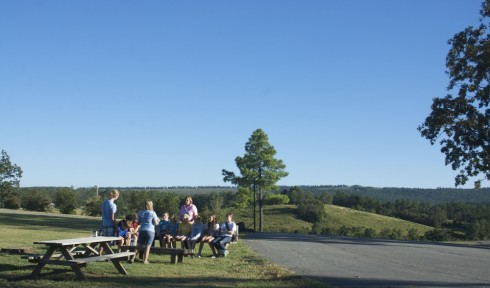
We’re off to Heifer International again with a new crop of middle-schoolers. This time Ms. Vranas is the other chaperone.
With stopping for lunch, stopping for gas, and stopping by a grocery to pick up supplies, the trip out lasted over 8 hours, but we made it out with everyone in good humor. The kids played Head’s Up Seven Up, and their own stashes of snack food.
I use these trips to introduce geology, specifically the dynamics of mountain-building and erosion using the Ozarks as an example. So every time we passed an outcrop (of which there were quite a number) I pointed it out and one of the students would invariably shout out “limestone” (and sometimes it actually was). I’ll actually try to take pictures of the outcrops on the way back when I’m not driving.
After dinners, I usually have the students spend an hour on reflection and discussion. The group gets split in two. While one half writes I discuss something we’ve seen with the other half.
I was planning to talk about the sequence of outcrops tonight, however, the discussion broke in a slightly different direction.
Just after crossing the Arkansas river, I’d asked the students why the land was so flat. It was because we were on the floodplain, but few of them had picked it up. In fact, most of them had not even noticed we’d crossed a fairly large river on a big concrete bridge not 30 seconds before.
So we started talking about why the flood plain is flat, then got on to the erosion of mountains and the deposition of the eroded material on the flood plains and river deltas. The key factor in erosion and deposition is the energy of the stream, which is a function of the slope. This in turn lead us to to talk about the Nile River – as an example -, which lead to the Great Pyramids, and how the fertility of floodplains lead to agriculture and civilization in Egypt, Mesopotamia, Cahokia, and along the Indus. I ended by pointing that most major cities are located on rivers because of their agricultural fertility, and perhaps more importantly today, the utility for transportation.

When the discussions and writing groups broke up, a few started to play Bananagrams, while the rest got a little rowdy. So I pulled them all in again and we talked a little about adolescent development, self-control, and the development of the frontal lobe, as I read them the riot act on proper behavior. It turned into a pretty neat discussion, because they ended up interrogating me about the way I behave toward them: why I always pause a moment before answering even their simplest questions; why I laughed two weeks ago when one of them told me that I was their, “least favorite teacher”; things like that.